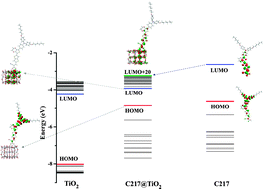Theoretical investigation of triphenylamine dye/titanium dioxide interface for dye-sensitized solar cells†
Abstract
The structural, electronic and optical features of two metal-free triphenylamine (TPA) organic

* Corresponding authors
a
State Key Laboratory of Molecular Reaction Dynamics, Dalian Institute of Chemical Physics, Chinese Academy of Sciences, Dalian 116023, China
E-mail:
dengwq@dicp.ac.cn
b Experimental Center of Chemistry, Faculty of Chemical, Environmental and Biological Science and Technology, Dalian University of Technology, Dalian 116024, P.R. China
The structural, electronic and optical features of two metal-free triphenylamine (TPA) organic

 Please wait while we load your content...
Something went wrong. Try again?
Please wait while we load your content...
Something went wrong. Try again?
W. Fan, D. Tan and W. Deng, Phys. Chem. Chem. Phys., 2011, 13, 16159 DOI: 10.1039/C1CP21308C
To request permission to reproduce material from this article, please go to the Copyright Clearance Center request page.
If you are an author contributing to an RSC publication, you do not need to request permission provided correct acknowledgement is given.
If you are the author of this article, you do not need to request permission to reproduce figures and diagrams provided correct acknowledgement is given. If you want to reproduce the whole article in a third-party publication (excluding your thesis/dissertation for which permission is not required) please go to the Copyright Clearance Center request page.
Read more about how to correctly acknowledge RSC content.
 Fetching data from CrossRef.
Fetching data from CrossRef.
This may take some time to load.
Loading related content
